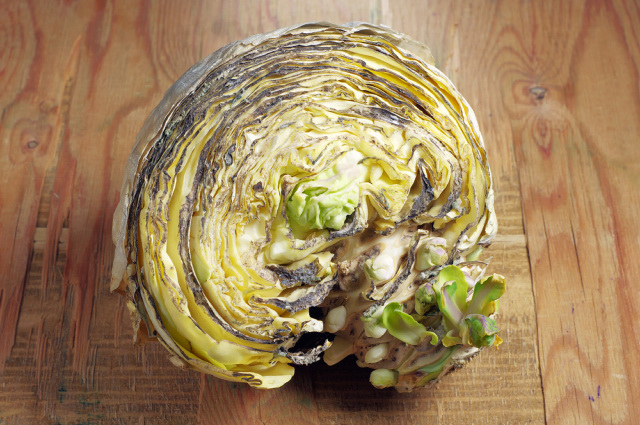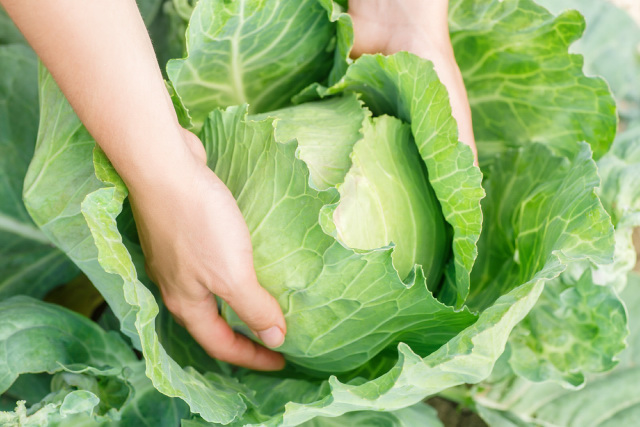If you’ve come across an overly bitter cabbage, you’re going to want to know why and how to make cabbage less bitter. So here’s everything you need to know about why cabbage sometimes tastes bitter, with solutions for how to fix it.

Table of Contents
- Why Cabbage Tastes Bitter
- How Gloucosinolates Make Cabbage Bitter
- Can You Eat Bitter Cabbage?
- Are Some Varieties of Cabbage More Bitter Than Others?
- How To Tell If Cabbage Has Gone Bad
- How To Select Good Cabbage At The Supermarket
- How Can You Make Cabbage Taste Better?
- Why Does My Cabbage Still Taste Bitter After Boiling It?
- How Growing Conditions Affect Cabbage Bitterness
- Some of My Favorite Kitchen Items:
Why Cabbage Tastes Bitter
The main reason that cabbage tastes bitter has to do with organic compounds in it called glucosinolates. These compounds have sulfur in them, which causes the cabbage to turn slightly bitter. Cabbage can also taste bitter because it is starting to go bad or due to mistakes made during the growing and harvesting process.
Let’s find out more.
How Gloucosinolates Make Cabbage Bitter
As mentioned, the organic sulfur compounds called glucosinolates are what make cabbage naturally taste bitter. The more glucosinolates that cabbage has, the more bitter it will taste.
The interesting thing about these compounds is that they don’t taste bitter until you cut the cabbage. This phenomenon happens because they act as a defense mechanism for the cabbage plant to prevent it from getting eaten by pests. When pests try to eat the cabbage as it grows, it will taste bitter to them and, theoretically, cause them to not further destroy the plant. Well, that’s the theory but as any gardener who grows cabbage will tell you, there are plenty of pests who will happily munch their way through cabbages!
Of course, no one will eat cabbage without cutting it first, so it’s nearly impossible to prevent this reaction from happening when preparing cabbage for consumption.
The longer the cabbage sits out after you cut it, the more these compounds will react and the more bitter it will taste. This chemical reaction is why raw cabbage cut ahead of time for a recipe will have a more pungent bitter taste than raw cabbage cut and eaten right away.
Can You Eat Bitter Cabbage?
Yes, you can eat bitter cabbage as long as it’s the natural compounds causing the bitterness in the vegetable. If your cabbage tastes bitter because it’s starting to go bad, you should toss it into the trash or the compost bin because it could cause you to get sick.
Are Some Varieties of Cabbage More Bitter Than Others?
Yes, the variety of cabbage also can affect its bitterness. Red cabbage tends to taste the most bitter of all the different varieties, though usually it is described as having a peppery taste. Green cabbage is similar to red cabbage and can often be used interchangeably in recipes, but it does not have quite as strong of a taste. Nappa and Savoy’s cabbage are varieties that are milder in flavor, and Nappa cabbage tends to have a much sweeter taste.
If the bitterness of red or green cabbage bothers you, try swapping it for the Nappa or Savoy variety. Keep in mind that the Savoy variety is not only less bitter than the others, but it also has leaves that are much less crisp. Therefore, it’s best to use this kind of cabbage in recipes where it will be sauteed or roasted.
How To Tell If Cabbage Has Gone Bad
Another reason that cabbage can taste bitter is that it is starting to rot. You will not want to eat cabbage that’s going bad, so you should know how to look for the signs that indicate your cabbage is no longer edible.
The following signs are indicators that the cabbage tastes bitter because it is no longer fresh:
- It has a pungent or sour smell to it. Fresh cabbage will not have a strong smell.
- It does not feel firm but has a soft or mushy texture.
- You see brown spots or other types of discolored areas on the cabbage.
If your cabbage shows any of these telltale signs, it’s time to throw it away.

How To Select Good Cabbage At The Supermarket
When you shop for cabbage at the grocery store, you want to make sure that you pick the freshest head. A very fresh head of cabbage has a long shelf life if stored properly in cold, moist conditions.
At the store, look for a cabbage head that has a bright color to it. This rule applies to red and green cabbage varieties, whose leaves should be tightly closed and shiny. Avoid any cabbages that appear to have had their outer leaves removed, as this signals that the store tried to remove the signs of aging.
You also want to select a larger head of cabbage, as the bigger heads typically have a less bitter flavor than a smaller, very compact head.
Next, feel around the cabbage to ensure that it’s firm and dense. A good cabbage will feel heavy for its size. If the cabbage feels soft and spongy, it might have started to rot inside.
Finally, check for any brown spots or other types of discoloration on the head of the cabbage. These signs indicate that the cabbage is old or pests have damaged it.
Note that you never want to purchase pre-cut cabbage from the grocery store as it will almost always have a bitter taste and will have already lost some nutrients.
How Can You Make Cabbage Taste Better?
A few methods exist that will help you to remove some of the bitterness of cabbage before you consume it. The method you should choose depends on whether you intend to eat the cabbage raw or cook it.
If Eating The Cabbage Raw
If you plan to use the cabbage in a salad or coleslaw, you can remove some of the bitter taste by chopping it up and putting the chopped leaves in a bowl with salt. Refrigerate the salted cabbage for a few hours. Although the salt won’t remove the bitterness altogether, it will draw some of the bitterness out and help cover up the taste.
After removing the cabbage from the refrigerator, rinse it thoroughly under cold water to remove the excess salt and rinse off any bitter liquid the salt removed.
You can also soak the cabbage for about 30 minutes in cold water after chopping it to neutralize some bitterness. Just make sure that you drain it well before using it in your recipe.
Another method is to cover up the bitter taste with something acidic, like lemon or a little bit of sugar. Many salads and coleslaw dressings have these ingredients, which is why they help the cabbage taste better.
For Cooked Cabbage
Cooking the cabbage should remove the bitterness pretty well. You can simply boil the cabbage, roast it, or braise it with butter. Adding salt, pepper, and other spices during this preparation will also help to enhance and improve its taste. You can also saute it with olive oil and onions, which will also remove the bitterness.
Why Does My Cabbage Still Taste Bitter After Boiling It?
If your cabbage still tastes bitter after boiling it, it likely means you overcooked it. You should only boil your cabbage for 12 to 15 minutes, depending on the size of your cabbage leaves. Or up to 20 min for cabbage left as wedges.
If you often find that boiling your cabbage causes it to taste extremely bitter, you can try another method of cooking it, such as roasting. Additionally, you could try adding some more salt to the water you boil or steam it in a steamer basket using well-salted water.
How Growing Conditions Affect Cabbage Bitterness
The Wrong Planting Time
Starting cabbages too late in the season will cause them to mature after the weather has already gotten too hot, making the cabbage more bitter tasting.
In certain colder climates, you can plant cabbage for two harvesting seasons—summer and fall.
If you want a summer crop, start the cabbages indoors, and when the threat of frost has passed. Then plant them out in the garden in the spring so your cabbage will be ready by the early summer.
For an autumn harvest, cabbage seeds should be sown directly in the garden in the middle of the summer (usually around mid-July).
Inconsistent Watering
Inconsistent watering during the growing process will cause the cabbage to taste excessively bitter. It will also give the cabbage an unappealing texture.
Too much or too little water can lead to bitter cabbage. So you want to water your cabbage around 2-3 times a week on a consistent basis.
Harvesting

It’s a good idea not to wait too long to harvest your cabbage once it has matured or you might be left with a bitter cabbage. Cabbage will generally take around 100 days to grow fully. And you’ll know your cabbage is ready when it reaches a usable size.
Since cabbage is primarily a cool-weather crop, you want to cut your summer harvest as early as possible in the season. Once it gets too hot, it will cause the cabbage to taste poorly.
A similar rule applies to an autumn harvest. Cabbage can survive cold temperatures. As a general rule, the closer it is to frost that you harvest the cabbage, the milder it will taste. So, if you’re looking to grow cabbage with a less-bitter taste, you may want to wait until after the first frost to harvest it.
Some of My Favorite Kitchen Items:
Related Reading:
